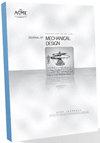半主动结构控制可调恒力机构的设计框架
IF 3
3区 工程技术
Q2 ENGINEERING, MECHANICAL
引用次数: 0
摘要
半主动可调恒力机构(ACFMs)是一种新兴的替代方案,用于需要恒力环境节能控制的应用。然而,文献中缺乏半主动acfm的设计策略。本研究通过提出一种通过结构控制半主动调节恒力的acfm设计策略来解决这一差距。提出了一种高长细比大行程CFM的优化设计框架,并通过重新定位边界条件位置来减小长细比以调整恒力的参数化研究。设计框架能够改变2-4倍的恒定力,行程分别为机构足迹的11-26%。制作并实验测试了一种具有较大力值的选定设计,表明恒力变化为主动控制设计的2.01倍,与主动控制设计相当,并且改进了紧凑性,即冲程占机构占地面积的11%。综上所述,所提出的ACFM设计框架最大化了初始CFM行程,并通过改变梁长细度实现了恒定的力调谐,从而实现了紧凑高效的ACFM设计。本文章由计算机程序翻译,如有差异,请以英文原文为准。
A design framework for semi-active structural controlled adjustable constant force mechanisms
Semi-active adjustable constant force mechanisms (ACFMs) are an emerging alternative in applications where energy-efficient control of constant force environments is required. However, there is a lack of design strategies in the literature for semi-active ACFMs. This study addresses this gap by presenting a design strategy for ACFMs that semi-actively tunes the constant force by structural control. A design framework is presented which consists of an optimization of a high slenderness large stroke CFM followed by a parametric study on adjusting constant force through slenderness reduction by repositioning the boundary condition location. The design framework was able to change constant force ranging from 2-4 times with a stroke of 11-26% of the mechanism footprint respectively. A selected design with a larger force magnitude was fabricated and experimentally tested, demonstrating a change in constant force of 2.01 times which is comparable to that of active control designs and improved compactness, i.e., stroke of 11% of the footprint of the mechanism. In conclusion, the proposed ACFM design framework maximizes the initial CFM stroke and achieves constant force tuning by changing beam slenderness, resulting in compact and efficient ACFM designs.
求助全文
通过发布文献求助,成功后即可免费获取论文全文。
去求助
来源期刊

Journal of Mechanical Design
工程技术-工程:机械
CiteScore
8.00
自引率
18.20%
发文量
139
审稿时长
3.9 months
期刊介绍:
The Journal of Mechanical Design (JMD) serves the broad design community as the venue for scholarly, archival research in all aspects of the design activity with emphasis on design synthesis. JMD has traditionally served the ASME Design Engineering Division and its technical committees, but it welcomes contributions from all areas of design with emphasis on synthesis. JMD communicates original contributions, primarily in the form of research articles of considerable depth, but also technical briefs, design innovation papers, book reviews, and editorials.
Scope: The Journal of Mechanical Design (JMD) serves the broad design community as the venue for scholarly, archival research in all aspects of the design activity with emphasis on design synthesis. JMD has traditionally served the ASME Design Engineering Division and its technical committees, but it welcomes contributions from all areas of design with emphasis on synthesis. JMD communicates original contributions, primarily in the form of research articles of considerable depth, but also technical briefs, design innovation papers, book reviews, and editorials.
 求助内容:
求助内容: 应助结果提醒方式:
应助结果提醒方式:


